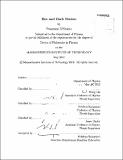Hot and dark matter
Author(s)
D'Eramo, Francesco
DownloadFull printable version (17.47Mb)
Alternative title
Jets in hot matter, novel dark matter and puzzling matters in supergravity
Other Contributors
Massachusetts Institute of Technology. Dept. of Physics.
Advisor
Hong Liu, Krishna Rajagopal and Jesse Thaler.
Terms of use
Metadata
Show full item recordAbstract
In this thesis, we build new Effective Field Theory tools to describe the propagation of energetic partons in hot and dense media, and we propose two new reactions for dark matter in the early universe. In the first part, we analyze the transverse momentum broadening in the absence of radiation of an energetic parton propagating through quark-gluon plasma via Soft Collinear Effective Theory (SCET). We show that the probability for picking up transverse momentum ki is given by the Fourier transform of the expectation value of two transversely separated light-like path-ordered Wilson lines. We evaluate the result for the strongly coupled plasma of N = 4 SYM theory by using gauge/gravity duality, and for the weakly coupled QCD plasma by using perturbation theory. In the second part, we introduce two new dark matter reactions, called "semi-annihilation" and "assimilation". The semi-annihilation reaction takes the schematic form [psi]i[psi]j -> [psi]k[psi], where [psi]i are stable dark matter particles and # is an unstable state. They lead to non-trivial dark matter dynamics in the early universe, and they might also take place today in the Milky Way, enriching the (semi-)annihilation final state spectrum observed in indirect detection experiments. The "assimilation" reaction efficiently destroy singlet dark matter particles, but dark matter number is stored in new quasi-stable heavy states which carry the baryon asymmetry. The subsequent annihilation and late-time decay of these heavy states yields (symmetric) dark matter as well as (asymmetric) standard model baryons.
Description
Thesis (Ph. D.)--Massachusetts Institute of Technology, Dept. of Physics, 2012. Cataloged from PDF version of thesis. Includes bibliographical references (p. 253-273).
Date issued
2012Department
Massachusetts Institute of Technology. Department of PhysicsPublisher
Massachusetts Institute of Technology
Keywords
Physics.